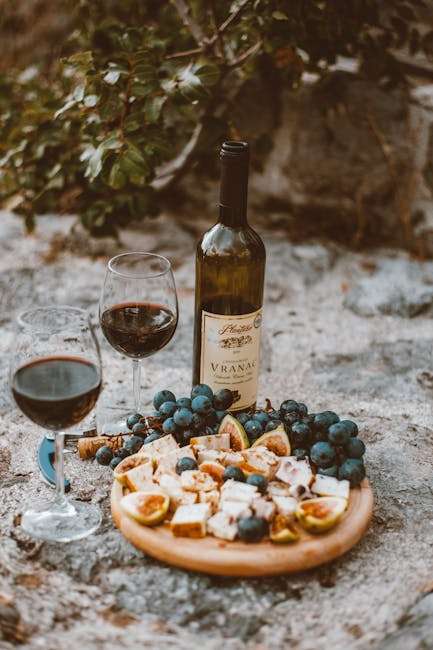A Beginner’s Guide to Pairing Wine with Food ?
When it comes to enjoying a delightful meal, the right wine pairing can elevate the experience to a whole new level. However, for beginners, the world of wine can seem overwhelming. Fear not! This guide will walk you through the basics of pairing wine with food, making your next dining experience both enjoyable and memorable.
Table of Contents
1. Introduction: Why Pair Wine with Food?
2. Understanding Wine Basics
3. Key Principles of Wine Pairing
4. Classic Wine and Food Pairings
5. Experimenting with New Flavors
6. Conclusion
7. FAQ
Introduction: Why Pair Wine with Food? ??
Wine and food pairing is more than just a tradition; it’s an art. The right combination can enhance flavors, create new taste sensations, and even bring out hidden notes in both the wine and the meal. Whether you’re hosting a dinner party or simply enjoying a quiet meal at home, understanding the basics of wine pairing can transform your dining experience.
Understanding Wine Basics ?
Before diving into pairings, it’s essential to grasp some wine fundamentals. Wines are generally classified into five main types: red, white, rosé, sparkling, and dessert wines. Each type has unique characteristics and flavor profiles.
Red Wines: Known for their bold flavors, red wines like Cabernet Sauvignon and Merlot are often full-bodied and rich.
White Wines: Typically lighter and more refreshing, white wines like Chardonnay and Sauvignon Blanc can range from dry to sweet.
Rosé Wines: A blend of red and white, rosé wines are light and often fruity.
Sparkling Wines: With bubbles that dance on your palate, sparkling wines like Champagne add elegance to any occasion.
Dessert Wines: Sweet and often served with or as dessert, these wines like Port and Sauternes are the perfect end to a meal.
Key Principles of Wine Pairing ??
Pairing wine with food isn’t an exact science, but some key principles can guide you:
1. Match Intensity: Pair light wines with delicate dishes and robust wines with hearty meals. A light Pinot Grigio with a fresh salad or a bold Malbec with a steak can be perfect matches.
2. Consider Acidity: Wines with high acidity, like a Sauvignon Blanc, can complement dishes with similar acidity, such as tomato-based sauces.
3. Balance Sweetness: Ensure that the wine is at least as sweet as the dish. A sweet Riesling can beautifully complement spicy Asian cuisine.
4. Contrast or Complement: Sometimes opposites attract, like a salty blue cheese paired with a sweet Port. Other times, complementary flavors, like a buttery Chardonnay with a creamy pasta, work wonders.
Classic Wine and Food Pairings ??
Here are some timeless pairings that never fail to impress:
Red Meat and Red Wine: A classic combination, beef pairs beautifully with robust red wines like Cabernet Sauvignon or Syrah.
White Meat and White Wine: Chicken and turkey are versatile, pairing well with both Chardonnay and Pinot Noir.
Fish and White Wine: Light fish dishes are best complemented by crisp white wines like Sauvignon Blanc or Pinot Grigio.
Pasta and Chianti: Italian dishes, especially those with tomato-based sauces, are enhanced by a glass of Chianti.
Desserts and Moscato: Sweet desserts find an ideal partner in the sweet and slightly effervescent Moscato.
Experimenting with New Flavors ?
Once you’re comfortable with the basics, don’t be afraid to experiment! Try pairing a spicy dish with a sweet wine to see how different flavors interact. Explore regional pairings by matching wines and cuisines from the same area, like a Spanish Tempranillo with a tapas spread. Remember, personal preference plays a huge role, so trust your palate and enjoy the journey!
Conclusion ?
Pairing wine with food is a delightful adventure that can enhance your culinary experiences. By understanding the basics and experimenting with new combinations, you can discover pairings that are perfect for your taste. So, grab a bottle, uncork it, and embark on your wine pairing journey. Cheers! ?
FAQ ?
1. What is the best wine for beginners? A versatile wine like Chardonnay or Pinot Noir is great for beginners because they pair well with a wide variety of foods.
2. Can I pair red wine with fish? While traditionally not recommended, lighter reds like Pinot Noir can work with rich fish dishes, such as salmon.
3. How should I store wine at home? Store wine in a cool, dark place on its side to keep the cork moist. Temperature should be consistent, ideally around 55°F (13°C).
4. Does the price of wine determine its quality? Not necessarily. Many affordable wines offer excellent quality, and personal preference should guide your choices.
5. Can I chill red wine? Yes, lighter reds like Beaujolais and Pinot Noir can be lightly chilled to enhance their flavors.
